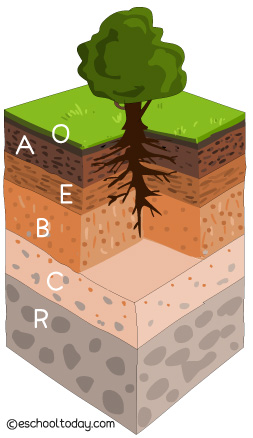- Soils
The Soil Profile
If one could dig a massive trench (hole), about 50-100ft vertically downwards into the ground, you will notice that you would have cut through various layers of soil types. A look at the layers from a distance gives one a cross-section view of the ground (beneath the surface) and the kind of soils and rocks it is made of.
This cross-section view is called a Soil Profile. The profile is made up of layers, running parallel to the surface, called Soil Horizons.
Each horizon may be slightly or very different from the other above or below it. Each horizon tells a story about the makeup, age, texture, and characteristics of that layer.
Most soils have three major horizons. These are A Horizon, B Horizon, and C Horizon. Aside from these three, there are also the O, E, and R horizons. How are they different?

The O-Horizon:
The O horizon is very common on many surfaces with lots of vegetative covers. It is the layer made up of organic materials such as dead leaves and surface organisms, twigs, and fallen trees. It has about 20% organic matter. It is possible to see various levels of decomposition occurring here (minimal, moderately, highly, and completely decomposed organic matter). This horizon is often black or dark brown in color, because of its organic content. It is the layer in which the roots of small grass are found.
The A-Horizon:
The A horizon may be seen in the absence of the O horizon, usually known as the topsoil. It is the top layer soils for many grasslands and agricultural lands. Typically, they are made of sand, silt, and clay with high amounts of organic matter. This layer is most vulnerable to wind and water erosion. It is also known as the root zone.
The E-Horizon:
The E horizon is usually lighter in color, often below the O and A horizons. It is often rich in nutrients that are leached from the top A and O horizons. It has a lower clay content and is common in forested lands or areas with high-quality O and A horizons.
The B-Horizon:
The B-horizon has some similarities with the E-horizon. This horizon is formed below the O, A, and E horizons and may contain high concentrations of silicate clay, iron, aluminum, and carbonates. It is also called the illuviation zone because of the accumulation of minerals. It is the layer in which the roots of big trees end.
The C-Horizon:
The C horizon lacks all the properties of the layers above it. It is mainly composed of broken bedrock and no organic material. It has cemented sediment and geologic material. There is little activity here although additions and losses of soluble materials may occur. The C horizon is also known as saprolite.
The R-Horizon:
The R horizon is the bedrock material, compacted and cemented by the weight of the overlying horizons. It is the unweathered parent material. Rock types found here include granite, basalt, and limestone.
